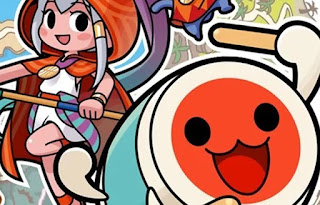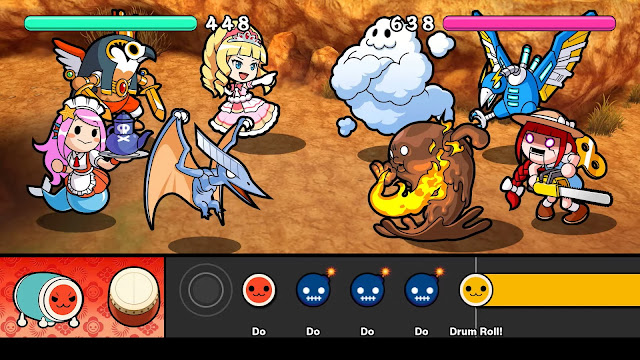Let me start by saying I really like Taiko. Drum ‘n’ Fun is one of my most played games on Switch, both in its rhythm-game and party-game modes. I was curious to see Taiko being converted into a JRPG in Rhythmic Adventure, and cautiously optimistic – rhythm/RPG hybrids don’t often work well, and when they do, it’s because either the rhythm or the RPG side is just window dressing. Taiko no Tatsujin Rhythmic Adventure contains elements of both genres, but the results don’t mesh well. Each game contains a thoroughly enjoyable rhythm game in the standard Taiko mode, as well as a simple JRPG driven by a rhythm-themed combat system. The RPG is a competent distraction but nothing essential – so I’d only recommend this game as a song-expansion to Taiko no Tatsujin: Drum ‘n’ Fun, or for younger audiences who want a simple, engaging JRPG.
For those who have never seen a Taiko game before – it’s a standard rhythm game where players need to hit buttons (or in this case, a drum) to the beat of a song. Hitting all the notes perfectly results in a higher score, and each side of Rhythmic Adventure 1+2 comes with around 50 songs, each with 4 difficulty levels. With songs from anime, vocaloid, video games and J-pop, the Taiko mode is more than enough for anyone seeking a solid rhythm game on the go – it’s Taiko as we know it, and Taiko is good. In arcades, Taiko no Tatsujin games come with a functioning replica of a traditional Japanese drum, where hitting the centre results in a Don (or red note) and hitting the rim is a Ka (blue note). Taiko has always been one of the more tactile rhythm games in the arcade circuit, with its drumrolls, double-strikes and large, eye-catching peripheral. This means the translation to Switch does leave out some of the appeal; in the game’s Taiko mode the player can use either buttons or motion controls to simulate hitting a drum, while the Adventure mode is button-controls only. The drum peripheral which came with the deluxe edition of Drum ‘n’ Fun also works in Taiko mode, but can’t be used for the RPG.
The reason would be because Rhythmic Adventure 1+2 is actually two 3DS games taped together and localised: the first being Jikuu Daibouken (Spacetime Adventure) and the second titled Mystery Adventure. Although the graphics have been tidied up, Rhythmic Adventure seems to be a fairly straightforward port and translation of the two games, with some songs added or removed. It means that the package bears some quality of life issues, most notably the two separate track lists between the games, forcing people who purchased 1+2 to go back to the menu and switch between each title if they want to play a song originally included with the other game. Taiko mode seems to use Drum ‘n’ Fun’s engine, while the Adventure mode uses something different. Because these adventure modes came before Drum ‘n’ Fun, and weren’t made with the Switch in mind, I couldn’t help but notice missed opportunities in the way the RPGs handle their minigames and battle systems.
The RPGs, from a design standpoint, are as standard as they come. Both see the series’ mascot drums Don and Katsu teaming up with a colourful cast of characters to traverse distant lands, collect key items and save the world. With drumming. The stories are whimsical and charming, but inconsequential; the real fun is in the interactions and jokes between the characters. The first game, for example, sees the player travelling to different eras in history in a quest to fix a time-travelling watch named Tocky; in doing so, they’ll see interactions between historical figures like a conversation between young Oda Nobunaga and Marie Antoinette. Meanwhile, the second sees Don and Katsu in a museum of cultural artefacts, needing to piece together an international conspiracy.
Unfortunately, I felt that the script was slightly lacking, there are times where the jokes fall flat and I was never sure if the issue was with the writing or the translation – it’s a story which does use tired stereotypes and thin characters, after all. Both games pad out their dialogue scenes with exploration and combat segments. The historical eras in the first game and the cultural hubs in the second are both divided into small overworld maps and towns. In towns, players can buy outfits, talk to the locals, and play a few songs for people who need your help. On the overworld, the first game subjects the player to random encounters constantly, but the second has a forgiving system of visible enemies which can be avoided by careful manoeuvring. Each world follows the same pattern – go to the town, meet a key figure, go to a dungeon, navigate a brief maze, and then fight a boss. The best compliment I can give either RPG is that they provide a decent amount of content, and they give the player a goal they can easily see and make progress at.
Combat thrusts players into a song chosen from each game’s track list (with each “world” having a small pool of songs it selects from), with the player’s party pitted against some enemies. The Taiko song unfolds at the bottom of the screen as usual, and once players rack up a good combo, the party members attack automatically. Enemies will stand there and let themselves get smacked about, only able to strike if the player misses a note or hits a bomb-note. Once all the enemies are defeated, the song immediately ends. Usually a combat will take up to a minute, by which point I’ve started liking the song and am disappointed to see it conclude abruptly – there’s actual psychology that suggests that not listening to a song in its entirety creates a certain anxiety, so it’s unfortunate that these games make a mechanic of it. On the other hand, if the song finishes before all enemies are defeated the battle is declared a Draw regardless of how much damage either side took. There are no strategic decisions to be made because players will understandably be too focused on hitting all the notes correctly, so the outcome to every fight is effectively determined before it even begins – either the player’s team is strong enough to clear the encounter, or they aren’t.
Each game has its own monster-collecting system, where enemies defeated in combat can be recruited to the player’s team. The RPG mechanics here are very simplified, I presume because of the rhythm-combat mechanics. Monsters have an HP, Attack and Speed stat, but defensive stats won’t matter once you’re able to perfect each song. Because battles can end in a tie, however, it is important to keep the Attack stat appropriately high for the area you’re exploring. Changing Don and Katsu’s costumes can give a small buff to your team depending on what class or combat-type they are, with the second game giving far more meaningful customisation options than the first. For what it’s worth, I did like the diversity and creativity of the enemy designs, and I collected and raised them if for no other purpose than their sheer novelty.
No matter how much heart the two games have with their Adventure modes though, I never fell in love with their mixing of JRPG and Rhythm genre tropes. Rhythm games are all about rewarding skill, practice and perfection, whilst JRPGs are about strategic decisions and narrative. Those two things fundamentally clash, and neither of the Adventure modes manages to reconcile these differences – it’s frustrating to have a song cut halfway through because all the enemies were vanquished, or to have to sit through dozens of random encounters (and thus play the same song over and over) to strengthen a party because in their current state they wouldn’t defeat the upcoming boss even with a full-combo on the associated song.
If the contents of each game’s track list don’t matter to you, then I would strongly suggest picking up the second game and skipping the first. The first game has infuriating random encounters, a weaker 4-character-party-system and simpler maps to explore – and while the second game’s 9-character-party and monster fusion systems don’t make the role-playing that much more meaningful, it’s still a smidge more engaging to play around with. Both games are much better in their standard Taiko game-modes however, and so I’d still recommend Drum ‘n’ Fun before either of these two – the party game mode in Drum ‘n’ Fun is a lot more complementary to the Taiko experience compared to the JRPGs in this collection. Combining the JRPG and Rhythm genres can make for some very engaging gameplay experiences, but Taiko Rhythmic Adventure 1+2 does not do it meaningfully enough to achieve any lasting appeal.










